Galaxies with Shells in the Illustris Simulation: Metallicity Signatures
Abstract
:1. Introduction
2. Simulations and Methods
2.1. Illustris
2.2. The Galaxy Sample
2.3. Stellar History Catalogs and Shell Galaxies Identification
- Step 1: Galaxies with stellar shells are visually identified using stellar surface density maps. Each galaxy in the sample is studied using all three projections (x–y, y–z, z–x) and two different contrast levels, and each image stamp received a score ranging from 0–2 from three different members of our team. A score of 2 indicates a galaxy with two or more well-defined shells, a score of 1 corresponds to galaxies with one or two shell-like structures, and a score of 0 indicates no shell detection. We order candidate shell galaxies based on the total scores given to all their corresponding image stamps. As discussed in P17, most shell galaxies exhibit shell-like structures in at least 2/3 projections, and we use the second identification step to verify the presence of shells in each of the candidate galaxies.
- Step 2: We develop stellar history catalogs in order to identify the shell-forming progenitors and separate stars in shells from all other stars in the galaxy. In these catalogs, we trace the birth, trajectory and progenitors of all star particles inside halos, saving information about each individual star particle at three key moments during its life: formation, accretion (when the parent satellite enters the virial radius of the host) and stripping time (when the star becomes gravitationally bound to the new host). In P17, we show that shells in Illustris are composed of ex-situ stars, which is in agreement with merger models predicting that shell-like structures correspond to overdensities of stripped stars accumulating at the apocenters of their orbits (see analytical and numerical studies by, e.g., [24,25,26,27,28,29,34,75,76]). By tracing the configuration and phase space ( vs. r) distribution of star particles with a common parent satellite, we obtain a systematic sample of all the satellites that are responsible for stellar shells.
3. Results and Implications
4. Summary
Acknowledgments
Author Contributions
Conflicts of Interest
References
- McConnachie, A.W.; Irwin, M.J.; Ibata, R.A.; Dubinski, J.; Widrow, L.M.; Martin, N.F.; Côté, P.; Dotter, A.L.; Navarro, J.F.; Ferguson, A.M.N.; et al. The remnants of galaxy formation from a panoramic survey of the region around M31. Nature 2009, 461, 66–69. [Google Scholar] [CrossRef] [PubMed]
- Martínez-Delgado, D.; Gabany, R.J.; Crawford, K.; Zibetti, S.; Majewski, S.R.; Rix, H.W.; Fliri, J.; Carballo-Bello, J.A.; Bardalez-Gagliuffi, D.C.; Peñarrubia, J.; et al. Stellar tidal streams in spiral galaxies of the local volume: A pilot survey with modest aperture telescopes. Astron. J. 2010, 140, 962–967. [Google Scholar] [CrossRef]
- Arp, H. Atlas of Peculiar Galaxies. Astrophys. J. Suppl. Ser. 1966, 14, 1. [Google Scholar] [CrossRef]
- Malin, D.F.; Carter, D. A catalog of elliptical galaxies with shells. Astron. J. 1983, 274, 534–540. [Google Scholar] [CrossRef]
- Schweizer, F. Observational evidence for mergers. In Internal Kinematics and Dynamics of Galaxies; Athanassoula, E., Ed.; Springer: Houten, The Netherlands, 1983; Volume 100, pp. 319–326. [Google Scholar]
- Schweizer, F.; Ford, W.K., Jr. Fine Structure in Elliptical Galaxies. In New Aspects of Galaxy Photometry; Nieto, J.L., Ed.; Springer: Berlin, Germany, 1985; Volume 232, p. 145. [Google Scholar]
- Tal, T.; van Dokkum, P.G.; Nelan, J.; Bezanson, R. The Frequency of Tidal Features Associated with Nearby Luminous Elliptical Galaxies from a Statistically Complete Sample. Astron. J. 2009, 138, 1417–1427. [Google Scholar] [CrossRef]
- Atkinson, A.M.; Abraham, R.G.; Ferguson, A.M.N. Faint Tidal Features in Galaxies within the Canada-France-Hawaii Telescope Legacy Survey Wide Fields. Astron. J. 2013, 765, 28. [Google Scholar] [CrossRef]
- Krajnović, D.; Emsellem, E.; Cappellari, M.; Alatalo, K.; Blitz, L.; Bois, M.; Bournaud, F.; Bureau, M.; Davies, R.L.; Davis, T.A.; et al. The ATLAS3D project—II. Morphologies, kinemetric features and alignment between photometric and kinematic axes of early-type galaxies. Mon. Not. R. Astron. Soc. 2011, 414, 2923–2949. [Google Scholar] [CrossRef]
- Duc, P.A. Using deep images and simulations to trace collisional debris around massive galaxies. arXiv, 2016; arXiv:1604.08364. [Google Scholar]
- Arnaboldi, M.; Ventimiglia, G.; Iodice, E.; Gerhard, O.; Coccato, L. A tale of two tails and an off-centered envelope: Diffuse light around the cD galaxy NGC 3311 in the Hydra I cluster. Astron. Astrophys. 2012, 545, A37. [Google Scholar] [CrossRef]
- Martínez-Delgado, D.; Romanowsky, A.J.; Gabany, R.J.; Annibali, F.; Arnold, J.A.; Fliri, J.; Zibetti, S.; van der Marel, R.P.; Rix, H.W.; Chonis, T.S.; et al. Dwarfs Gobbling Dwarfs: A Stellar Tidal Stream around NGC 4449 and Hierarchical Galaxy Formation on Small Scales. Astrophys. J. Lett. 2012, 748, L24. [Google Scholar] [CrossRef]
- Romanowsky, A.J.; Strader, J.; Brodie, J.P.; Mihos, J.C.; Spitler, L.R.; Forbes, D.A.; Foster, C.; Arnold, J.A. The Ongoing Assembly of a Central Cluster Galaxy: Phase-space Substructures in the Halo of M87. Astrophys. J. 2012, 748, 29. [Google Scholar] [CrossRef]
- Foster, C.; Lux, H.; Romanowsky, A.J.; Martínez-Delgado, D.; Zibetti, S.; Arnold, J.A.; Brodie, J.P.; Ciardullo, R.; GaBany, R.J.; Merrifield, M.R.; et al. Kinematics and simulations of the stellar stream in the halo of the Umbrella Galaxy. Mon. Not. R. Astron. Soc. 2014, 442, 3544–3564. [Google Scholar] [CrossRef]
- Longobardi, A.; Arnaboldi, M.; Gerhard, O.; Mihos, J.C. The build-up of the cD halo of M 87: Evidence for accretion in the last Gyr. Astron. Astrophys. 2015, 579, L3. [Google Scholar] [CrossRef]
- Amorisco, N.C.; Martinez-Delgado, D.; Schedler, J. A dwarf galaxy’s transformation and a massive galaxy’s edge: Autopsy of kill and killer in NGC 1097. arXiv, 2015; arXiv:1504.03697. [Google Scholar]
- Pop, A.R.; Pillepich, A.; Amorisco, N.C.; Hernquist, L. Formation and Incidence of Shell Galaxies in the Illustris Simulation. arXiv, 2017; arXiv:1706.06102. [Google Scholar]
- Fabian, A.C.; Nulsen, P.E.J.; Stewart, G.C. Star formation in a galactic wind. Nature 1980, 287, 613–614. [Google Scholar] [CrossRef]
- Bertschinger, E. Self-similar secondary infall and accretion in an Einstein-de Sitter universe. Astrophys. J. Suppl. Ser. 1985, 58, 39–65. [Google Scholar] [CrossRef]
- Williams, R.E.; Christiansen, W.A. Blast wave formation of the extended stellar shells surrounding elliptical galaxies. Astrophys. J. 1985, 291, 80–87. [Google Scholar] [CrossRef]
- Loewenstein, M.; Fabian, A.C.; Nulsen, P.E.J. Formation of shells in elliptical galaxies from interstellar gas. Mon. Not. R. Astron. Soc. 1987, 229, 129–141. [Google Scholar] [CrossRef]
- Thomson, R.C.; Wright, A.E. A Weak Interaction Model for Shell Galaxies. Mon. Not. R. Astron. Soc. 1990, 247, 122. [Google Scholar]
- Thomson, R.C. Shell formation in elliptical galaxies. Mon. Not. R. Astron. Soc. 1991, 253, 256–278. [Google Scholar] [CrossRef]
- Quinn, P.J. On the formation and dynamics of shells around elliptical galaxies. Astrophys. J. 1984, 279, 596–609. [Google Scholar] [CrossRef]
- Dupraz, C.; Combes, F. Shells around galaxies—Testing the mass distribution and the 3-D shape of ellipticals. Astron. Astrophys. 1986, 166, 53–74. [Google Scholar]
- Hernquist, L.; Quinn, P.J. Formation of shell galaxies. I—Spherical potentials. Astrophys. J. 1988, 331, 682–698. [Google Scholar] [CrossRef]
- Hernquist, L.; Quinn, P.J. Formation of shell galaxies. II—Nonspherical potentials. Astrophys. J. 1989, 342, 1–16. [Google Scholar] [CrossRef]
- Sanderson, R.E.; Bertschinger, E. Seen and Unseen Tidal Caustics in the Andromeda Galaxy. Astrophys. J. 2010, 725, 1652–1675. [Google Scholar] [CrossRef]
- Sanderson, R.E.; Helmi, A. An analytical phase-space model for tidal caustics. Mon. Not. R. Astron. Soc. 2013, 435, 378–399. [Google Scholar] [CrossRef]
- Hernquist, L.; Quinn, P.J. Shell galaxies and alternatives to the dark matter hypothesis. Astrophys. J. 1987, 312, 17–21. [Google Scholar] [CrossRef]
- Seguin, P.; Dupraz, C. Dynamical friction in head-on galaxy collisions. II. N-body simulations of radial and non-radial encounters. Astron. Astrophys. 1996, 310, 757–770. [Google Scholar]
- Bartošková, K.; Jungwiert, B.; Ebrová, I.; Jílková, L.; Křížek, M. Simulations of Shell Galaxies with GADGET-2: Multi-Generation Shell Systems. Astrophys. Space Sci. Proc. 2011, 27, 195. [Google Scholar]
- Ebrová, I.; Jílková, L.; Jungwiert, B.; Křížek, M.; Bílek, M.; Bartošková, K.; Skalická, T.; Stoklasová, I. Quadruple-peaked spectral line profiles as a tool to constrain gravitational potential of shell galaxies. Astron. Astrophys. 2012, 545, A33. [Google Scholar] [CrossRef]
- Hernquist, L.; Spergel, D.N. Formation of shells in major mergers. Astrophys. J. 1992, 399, L117–L120. [Google Scholar] [CrossRef]
- González-García, A.C.; Balcells, M. Elliptical galaxies from mergers of discs. Mon. Not. R. Astron. Soc. 2005, 357, 753–772. [Google Scholar] [CrossRef]
- González-García, A.C.; van Albada, T.S. Encounters between spherical galaxies—I. Systems without a dark halo. Mon. Not. R. Astron. Soc. 2005, 361, 1030–1042. [Google Scholar] [CrossRef] [Green Version]
- González-García, A.C.; van Albada, T.S. Encounters between spherical galaxies—II. Systems with a dark halo. Mon. Not. R. Astron. Soc. 2005, 361, 1043–1054. [Google Scholar] [CrossRef]
- Hirschmann, M.; Naab, T.; Ostriker, J.P.; Forbes, D.A.; Duc, P.A.; Davé, R.; Oser, L.; Karabal, E. The stellar accretion origin of stellar population gradients in massive galaxies at large radii. Mon. Not. R. Astron. Soc. 2015, 449, 528–550. [Google Scholar] [CrossRef]
- Kobayashi, C. GRAPE-SPH chemodynamical simulation of elliptical galaxies—I. Evolution of metallicity gradients. Mon. Not. R. Astron. Soc. 2004, 347, 740–758. [Google Scholar] [CrossRef]
- Carlberg, R.G. Dissipative formation of an elliptical galaxy. Astrophys. J. 1984, 286, 403–415. [Google Scholar] [CrossRef]
- Bekki, K.; Shioya, Y. Stellar Populations in Gas-rich Galaxy Mergers. II. Feedback Effects of Type IA and Type II Supernovae. Astrophys. J. 1999, 513, 108–127. [Google Scholar] [CrossRef] [Green Version]
- Di Matteo, P.; Pipino, A.; Lehnert, M.D.; Combes, F.; Semelin, B. On the survival of metallicity gradients to major dry-mergers. Astron. Astrophys. 2009, 499, 427–437. [Google Scholar] [CrossRef]
- Font, A.S.; McCarthy, I.G.; Crain, R.A.; Theuns, T.; Schaye, J.; Wiersma, R.P.C.; Dalla Vecchia, C. Cosmological simulations of the formation of the stellar haloes around disc galaxies. Mon. Not. R. Astron. Soc. 2011, 416, 2802–2820. [Google Scholar] [CrossRef]
- Cook, B.A.; Conroy, C.; Pillepich, A.; Rodriguez-Gomez, V.; Hernquist, L. The Information Content of Stellar Halos: Stellar Population Gradients and Accretion Histories in Early-type Illustris Galaxies. Astrophys. J. 2016, 833, 158. [Google Scholar] [CrossRef]
- Longhetti, M.; Bressan, A.; Chiosi, C.; Rampazzo, R. Star formation history of early-type galaxies in low density environments. IV. What do we learn from nuclear line-strength indices? Astron. Astrophys. 2000, 353, 917–929. [Google Scholar]
- Carlsten, S.; Hau, G.K.T.; Zenteno, A. Stellar Populations of Shell Galaxies. arXiv, 2016; arXiv:1611.05437. [Google Scholar]
- Bender, R.; Burstein, D.; Faber, S.M. Dynamically hot galaxies. II—Global stellar populations. Astrophys. J. 1993, 411, 153–169. [Google Scholar] [CrossRef]
- Johnston, K.V.; Bullock, J.S.; Sharma, S.; Font, A.; Robertson, B.E.; Leitner, S.N. Tracing Galaxy Formation with Stellar Halos. II. Relating Substructure in Phase and Abundance Space to Accretion Histories. Astrophys. J. 2008, 689, 936–957. [Google Scholar] [CrossRef]
- Rejkuba, M.; Greggio, L.; Harris, W.E.; Harris, G.L.H.; Peng, E.W. Deep ACS Imaging of the Halo of NGC 5128: Reaching the Horizontal Branch. Astrophys. J. 2005, 631, 262–279. [Google Scholar] [CrossRef]
- Rejkuba, M.; Harris, W.E.; Greggio, L.; Harris, G.L.H. How old are the stars in the halo of NGC 5128 (Centaurus A)? Astron. Astrophys. 2011, 526, A123. [Google Scholar] [CrossRef]
- Rejkuba, M.; Harris, W.E.; Greggio, L.; Harris, G.L.H.; Jerjen, H.; Gonzalez, O.A. Tracing the Outer Halo in a Giant Elliptical to 25 Reff. Astrophy. J. Lett. 2014, 791, L2. [Google Scholar] [CrossRef]
- Mihos, J.C.; Harding, P.; Rudick, C.S.; Feldmeier, J.J. Stellar Populations in the Outer Halo of the Massive Elliptical M49. Astrophy. J. Lett. 2013, 764, L20. [Google Scholar] [CrossRef]
- Sánchez-Blázquez, P.; Forbes, D.A.; Strader, J.; Brodie, J.; Proctor, R. Spatially resolved spectroscopy of early-type galaxies over a range in mass. Mon. Not. R. Astron. Soc. 2007, 377, 759–786. [Google Scholar] [CrossRef]
- Foster, C.; Proctor, R.N.; Forbes, D.A.; Spolaor, M.; Hopkins, P.F.; Brodie, J.P. Metallicity gradients at large galactocentric radii using the near-infrared Calcium triplet. Mon. Not. R. Astron. Soc. 2009, 400, 2135–2146. [Google Scholar] [CrossRef]
- Spolaor, M.; Kobayashi, C.; Forbes, D.A.; Couch, W.J.; Hau, G.K.T. Early-type galaxies at large galactocentric radii—II. Metallicity gradients and the [Z/H]-mass, [α/Fe]-mass relations. Mon. Not. R. Astron. Soc. 2010, 408, 272–292. [Google Scholar] [CrossRef] [Green Version]
- Coccato, L.; Gerhard, O.; Arnaboldi, M. Distinct core and halo stellar populations and the formation history of the bright Coma cluster early-type galaxy NGC 4889. Mon. Not. R. Astron. Soc. 2010, 407, L26–L30. [Google Scholar] [CrossRef]
- Coccato, L.; Gerhard, O.; Arnaboldi, M.; Ventimiglia, G. Stellar population and the origin of intra-cluster stars around brightest cluster galaxies: The case of NGC 3311. Astron. Astrophys. 2011, 533, A138. [Google Scholar] [CrossRef]
- Kuntschner, H.; Emsellem, E.; Bacon, R.; Cappellari, M.; Davies, R.L.; de Zeeuw, P.T.; Falcón-Barroso, J.; Krajnović, D.; McDermid, R.M.; Peletier, R.F.; et al. The SAURON project—XVII. Stellar population analysis of the absorption line strength maps of 48 early-type galaxies. Mon. Not. R. Astron. Soc. 2010, 408, 97–132. [Google Scholar] [CrossRef] [Green Version]
- Weijmans, A.M.; Cappellari, M.; Bacon, R.; de Zeeuw, P.T.; Emsellem, E.; Falcón-Barroso, J.; Kuntschner, H.; McDermid, R.M.; van den Bosch, R.C.E.; van de Ven, G. Stellar velocity profiles and line strengths out to four effective radii in the early-type galaxies NGC3379 and 821. Mon. Not. R. Astron. Soc. 2009, 398, 561–574. [Google Scholar] [CrossRef]
- Greene, J.E.; Janish, R.; Ma, C.P.; McConnell, N.J.; Blakeslee, J.P.; Thomas, J.; Murphy, J.D. The MASSIVE Survey. II. Stellar Population Trends Out to Large Radius in Massive Early-type Galaxies. Astrophy. J. 2015, 807, 11. [Google Scholar] [CrossRef]
- González Delgado, R.M.; García-Benito, R.; Pérez, E.; Cid Fernandes, R.; de Amorim, A.L.; Cortijo-Ferrero, C.; Lacerda, E.A.D.; López Fernández, R.; Vale-Asari, N.; Sánchez, S.F.; et al. The CALIFA survey across the Hubble sequence. Spatially resolved stellar population properties in galaxies. Astron. Astrophys. 2015, 581, A103. [Google Scholar] [CrossRef]
- Wilkinson, D.M.; Maraston, C.; Thomas, D.; Coccato, L.; Tojeiro, R.; Cappellari, M.; Belfiore, F.; Bershady, M.; Blanton, M.; Bundy, K.; et al. P-MaNGA: Full spectral fitting and stellar population maps from prototype observations. Mon. Not. R. Astron. Soc. 2015, 449, 328–360. [Google Scholar] [CrossRef] [Green Version]
- Harris, W.E.; Harris, G.L.H.; Layden, A.C.; Wehner, E.M.H. The Leo Elliptical NGC 3379: A Metal-Poor Halo Emerges. ApJ 2007, 666, 903–918. [Google Scholar] [CrossRef]
- Lee, M.G.; Jang, I.S. Dual Stellar Halos in the Standard Elliptical Galaxy M105 and Formation of Massive Early-type Galaxies. Astrophy. J. 2016, 822, 70. [Google Scholar] [CrossRef]
- Pastorello, N.; Forbes, D.A.; Foster, C.; Brodie, J.P.; Usher, C.; Romanowsky, A.J.; Strader, J.; Arnold, J.A. The SLUGGS survey: Exploring the metallicity gradients of nearby early-type galaxies to large radii. Mon. Not. R. Astron. Soc. 2014, 442, 1003–1039. [Google Scholar] [CrossRef]
- Vogelsberger, M.; Genel, S.; Springel, V.; Torrey, P.; Sijacki, D.; Xu, D.; Snyder, G.; Bird, S.; Nelson, D.; Hernquist, L. Properties of galaxies reproduced by a hydrodynamic simulation. Nature 2014, 509, 177–182. [Google Scholar] [CrossRef] [PubMed]
- Vogelsberger, M.; Genel, S.; Springel, V.; Torrey, P.; Sijacki, D.; Xu, D.; Snyder, G.; Nelson, D.; Hernquist, L. Introducing the Illustris Project: Simulating the coevolution of dark and visible matter in the Universe. Mon. Not. R. Astron. Soc. 2014, 444, 1518–1547. [Google Scholar] [CrossRef]
- Genel, S.; Vogelsberger, M.; Springel, V.; Sijacki, D.; Nelson, D.; Snyder, G.; Rodriguez-Gomez, V.; Torrey, P.; Hernquist, L. Introducing the Illustris project: The evolution of galaxy populations across cosmic time. Mon. Not. R. Astron. Soc. 2014, 445, 175–200. [Google Scholar] [CrossRef]
- Springel, V. E pur si muove: Galilean-invariant cosmological hydrodynamical simulations on a moving mesh. Mon. Not. R. Astron. Soc. 2010, 401, 791–851. [Google Scholar] [CrossRef]
- Vogelsberger, M.; Genel, S.; Sijacki, D.; Torrey, P.; Springel, V.; Hernquist, L. A model for cosmological simulations of galaxy formation physics. Mon. Not. R. Astron. Soc. 2013, 436, 3031–3067. [Google Scholar] [CrossRef]
- Torrey, P.; Vogelsberger, M.; Genel, S.; Sijacki, D.; Springel, V.; Hernquist, L. A model for cosmological simulations of galaxy formation physics: Multi-epoch validation. Mon. Not. R. Astron. Soc. 2014, 438, 1985–2004. [Google Scholar] [CrossRef]
- Davis, M.; Efstathiou, G.; Frenk, C.S.; White, S.D.M. The evolution of large-scale structure in a universe dominated by cold dark matter. Astrophy. J. 1985, 292, 371–394. [Google Scholar] [CrossRef]
- Springel, V.; Yoshida, N.; White, S.D.M. GADGET: A code for collisionless and gasdynamical cosmological simulations. New Astron. 2001, 6, 79–117. [Google Scholar] [CrossRef]
- Dolag, K.; Borgani, S.; Murante, G.; Springel, V. Substructures in hydrodynamical cluster simulations. Mon. Not. R. Astron. Soc. 2009, 399, 497–514. [Google Scholar] [CrossRef]
- Amorisco, N.C. On feathers, bifurcations and shells: The dynamics of tidal streams across the mass scale. Mon. Not. R. Astron. Soc. 2015, 450, 575–591. [Google Scholar] [CrossRef]
- Hendel, D.; Johnston, K.V. Tidal debris morphology and the orbits of satellite galaxies. Mon. Not. R. Astron. Soc. 2015, 454, 2472–2485. [Google Scholar] [CrossRef]
- Salmon, J.; Quinn, P.J.; Warren, M. Using parallel computers for very large N-body simulations: Shell formation using 180 K particles. In Dynamics and Interactions of Galaxies; Wielen, R., Ed.; Springer: Heidelberg, Germany, 1990; pp. 216–218. [Google Scholar]
- Cooper, A.P.; Martínez-Delgado, D.; Helly, J.; Frenk, C.; Cole, S.; Crawford, K.; Zibetti, S.; Carballo-Bello, J.A.; GaBany, R.J. The Formation of Shell Galaxies Similar to NGC 7600 in the Cold Dark Matter Cosmogony. Astrophy. J. Lett. 2011, 743, L21. [Google Scholar] [CrossRef]
- Boylan-Kolchin, M.; Ma, C.P.; Quataert, E. Dynamical friction and galaxy merging time-scales. Mon. Not. R. Astron. Soc. 2008, 383, 93–101. [Google Scholar] [CrossRef]
- Amorisco, N.C. Contributions to the accreted stellar halo: An atlas of stellar deposition. Mon. Not. R. Astron. Soc. 2017, 464, 2882–2895. [Google Scholar] [CrossRef]
- Rodriguez-Gomez, V.; Pillepich, A.; Sales, L.V.; Genel, S.; Vogelsberger, M.; Zhu, Q.; Wellons, S.; Nelson, D.; Torrey, P.; Springel, V.; et al. The stellar mass assembly of galaxies in the Illustris simulation: Growth by mergers and the spatial distribution of accreted stars. Mon. Not. R. Astron. Soc. 2016, 458, 2371–2390. [Google Scholar] [CrossRef]
- Dupraz, C.; Combes, F. Dynamical friction and shells around elliptical galaxies. Astron. Astrophys. 1987, 185, L1–L4. [Google Scholar]
- Wilkinson, A.; Sparks, W.B.; Carter, D.; Malin, D.A. Two Colour CCD Photometry of Malin/Carter Shell Galaxies. In Structure and Dynamics of Elliptical Galaxies; de Zeeuw, P.T., Ed.; Springer: Houten, The Netherlands, 1987; Volume 127, p. 465. [Google Scholar]
| 1. | We provide Poisson errors for the fractions of galaxies with shells in Illustris. However, the actual uncertainties in the could be higher due to environment (rich groups and clusters vs. field galaxies), mass distribution of galaxies in the sample, redshift evolution , surface brightness limits, and projection effects. For more details about the impact of these effects, see the discussion in Pop et al. [17]. |
| 2. | The radial velocity ratio () is defined as the radial component of the relative velocity of the satellite (), normalized to the modulus of the relative velocity (v). |
| 3. | We assign stars to each target area by selecting all star particles gravitationally bound to the galaxy and located inside a rectangular box with (y–z) square cross-section of area and infinite length. |
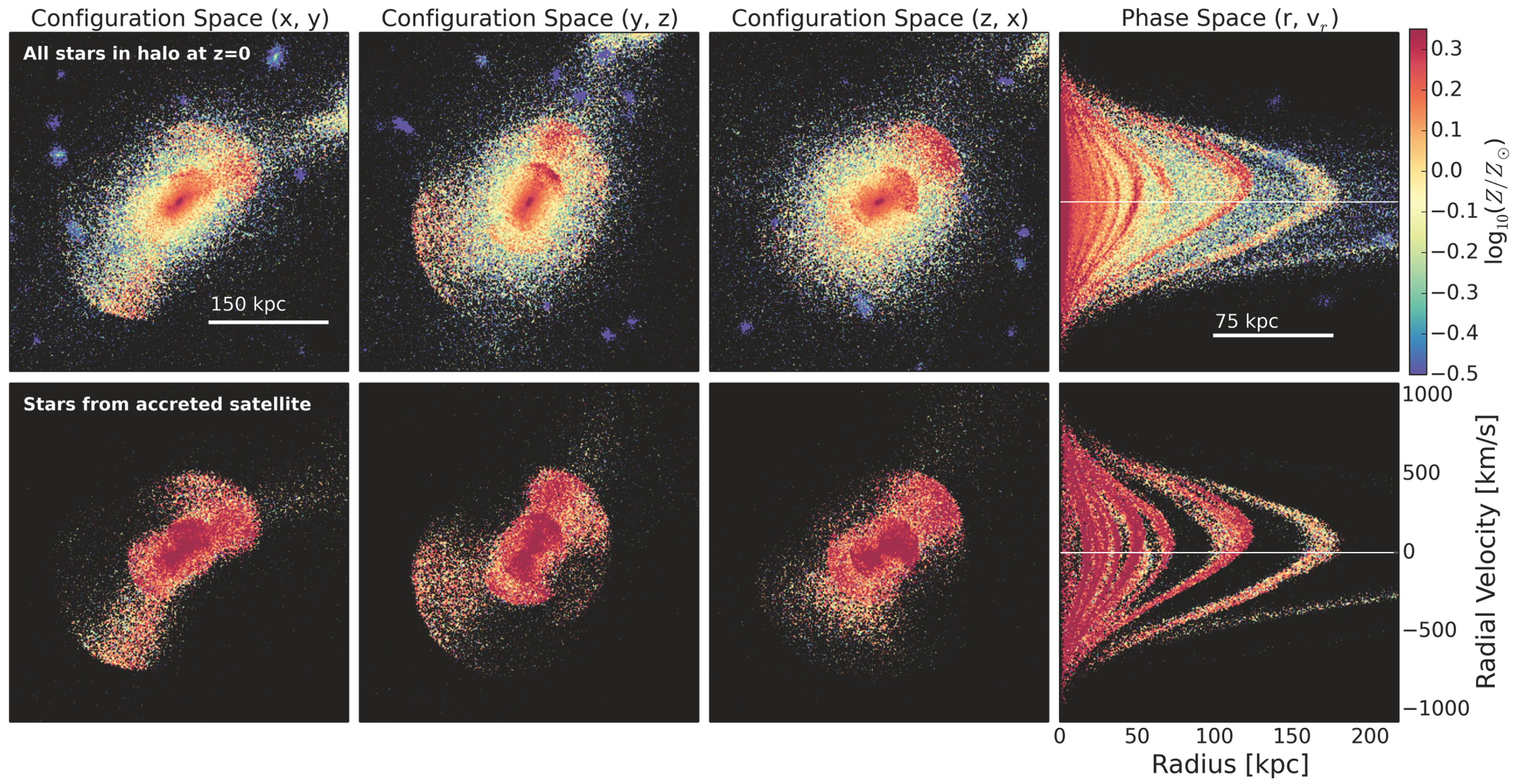
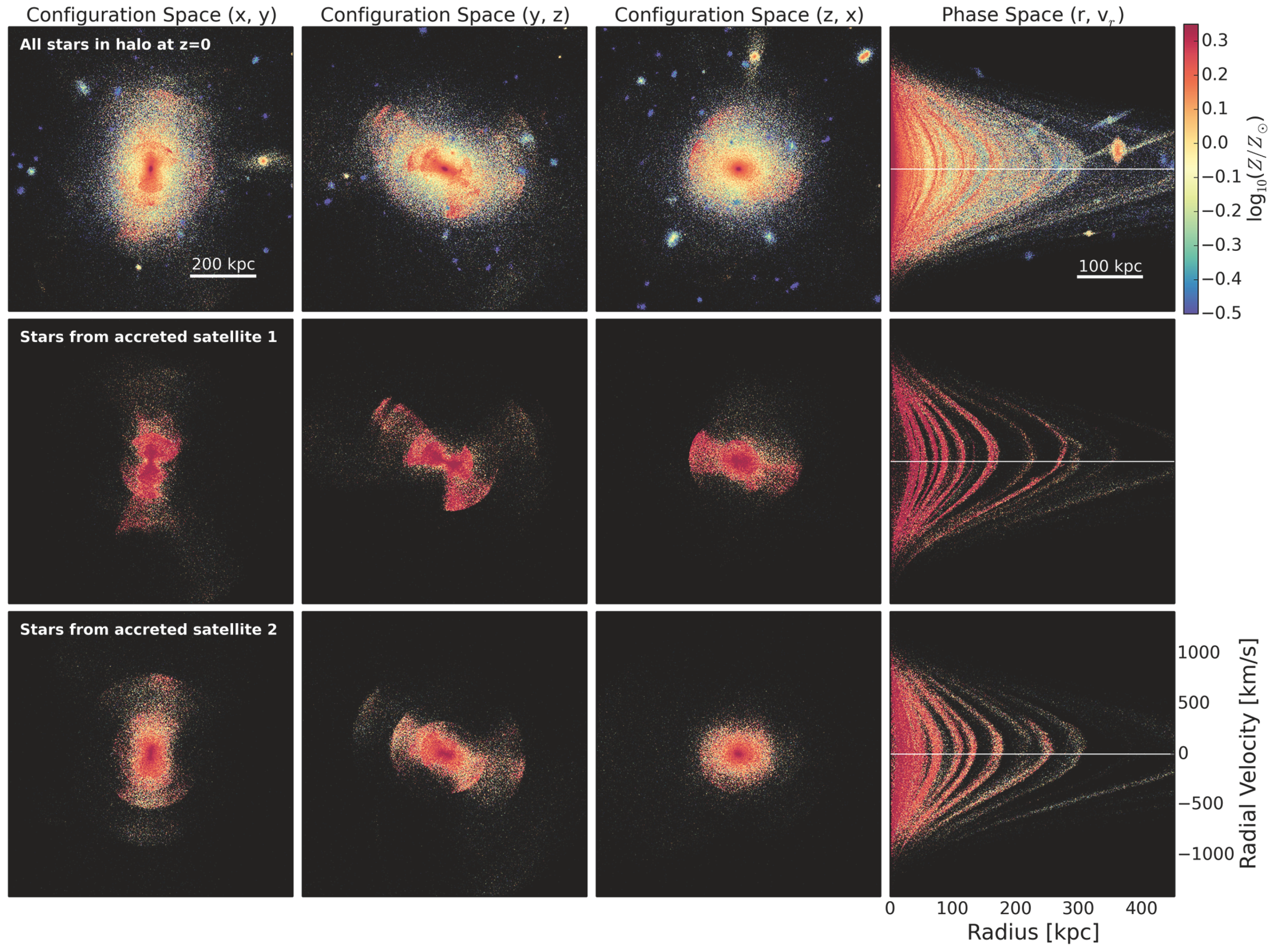
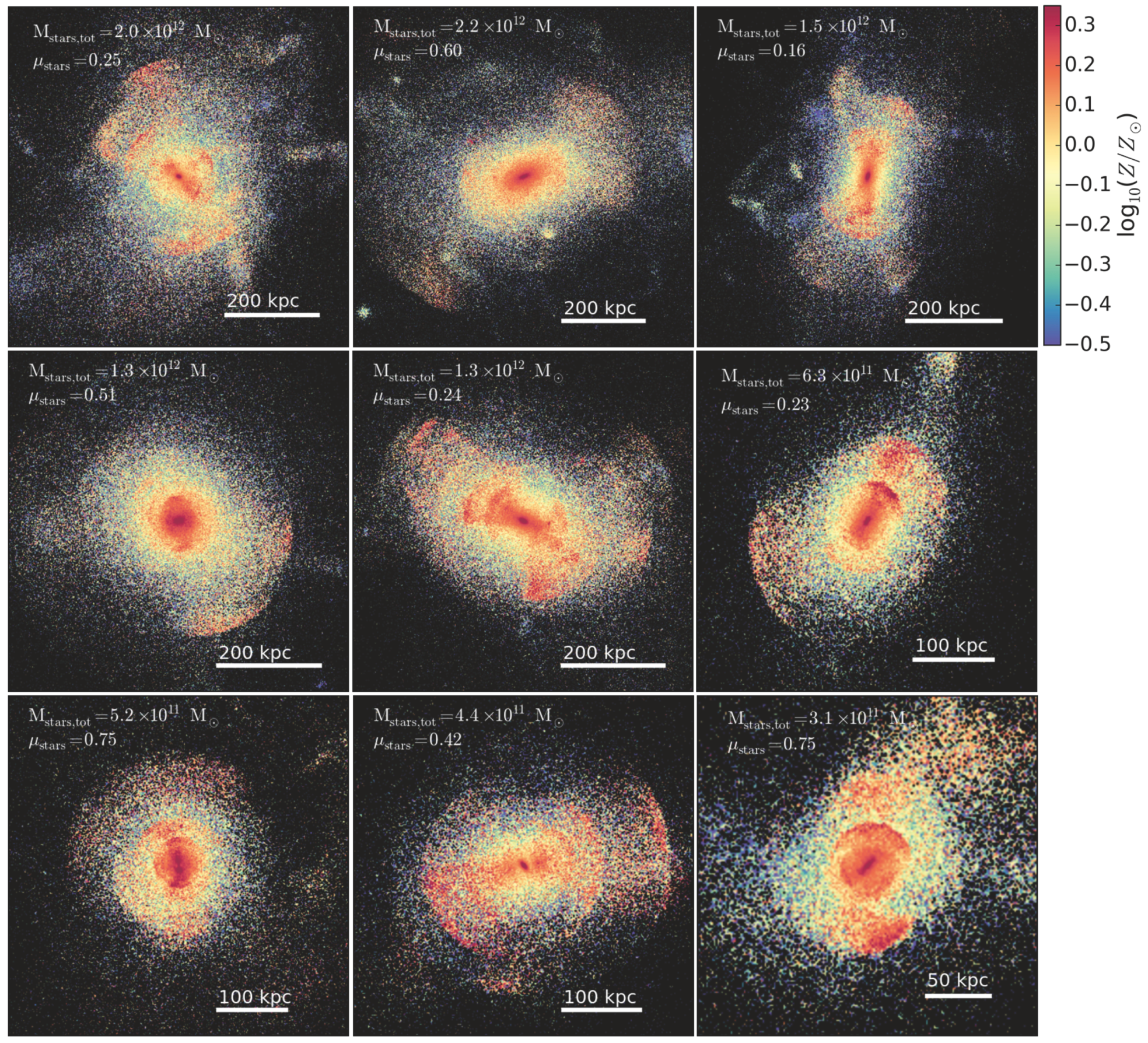
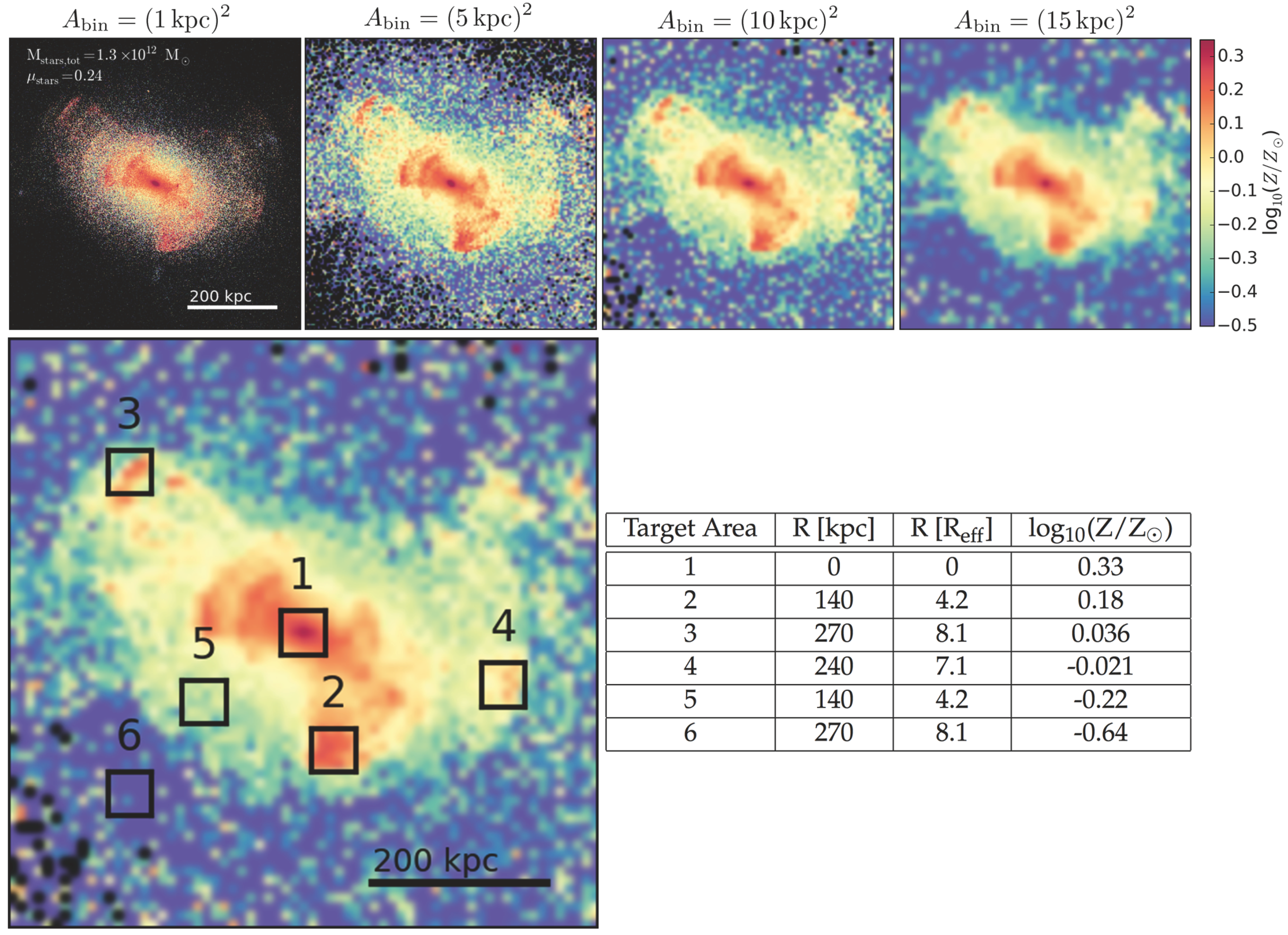
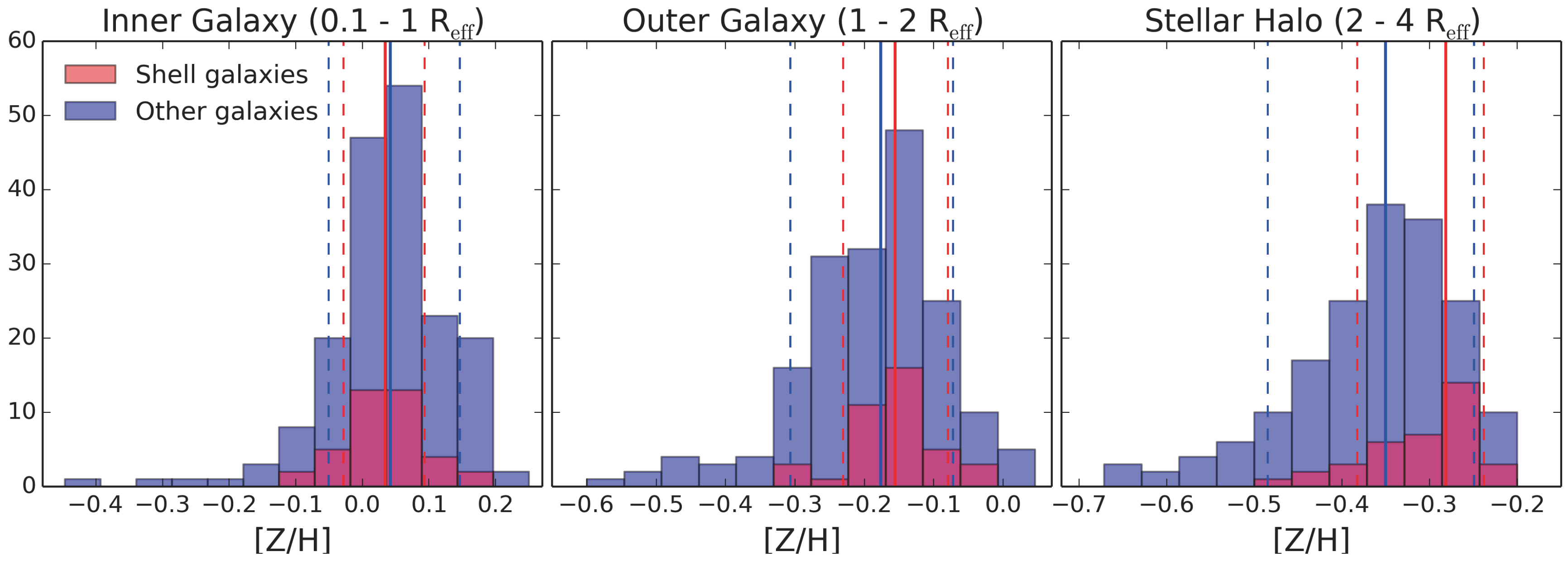
© 2017 by the authors. Licensee MDPI, Basel, Switzerland. This article is an open access article distributed under the terms and conditions of the Creative Commons Attribution (CC BY) license (http://creativecommons.org/licenses/by/4.0/).
Share and Cite
Pop, A.-R.; Pillepich, A.; Amorisco, N.C.; Hernquist, L. Galaxies with Shells in the Illustris Simulation: Metallicity Signatures. Galaxies 2017, 5, 34. https://doi.org/10.3390/galaxies5030034
Pop A-R, Pillepich A, Amorisco NC, Hernquist L. Galaxies with Shells in the Illustris Simulation: Metallicity Signatures. Galaxies. 2017; 5(3):34. https://doi.org/10.3390/galaxies5030034
Chicago/Turabian StylePop, Ana-Roxana, Annalisa Pillepich, Nicola C. Amorisco, and Lars Hernquist. 2017. "Galaxies with Shells in the Illustris Simulation: Metallicity Signatures" Galaxies 5, no. 3: 34. https://doi.org/10.3390/galaxies5030034




